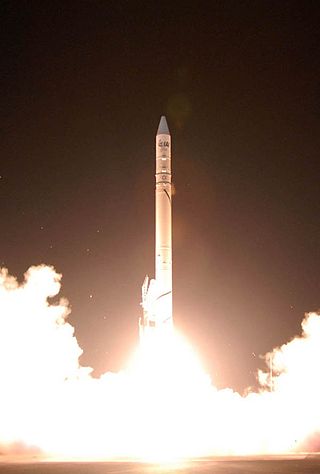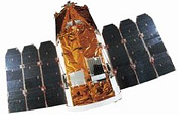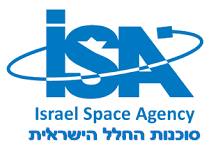
An Earth observation satellite or Earth remote sensing satellite is a satellite used or designed for Earth observation (EO) from orbit, including spy satellites and similar ones intended for non-military uses such as environmental monitoring, meteorology, cartography and others. The most common type are Earth imaging satellites, that take satellite images, analogous to aerial photographs; some EO satellites may perform remote sensing without forming pictures, such as in GNSS radio occultation.

Israel Aerospace Industries or IAI (תע"א) is Israel's major aerospace and aviation manufacturer, producing aerial and astronautic systems for both military and civilian usage. It has 15,000 employees as of 2018. IAI is state-owned by the government of Israel.

Satellite images are images of Earth collected by imaging satellites operated by governments and businesses around the world. Satellite imaging companies sell images by licensing them to governments and businesses such as Apple Maps and Google Maps.

Ofeq, also spelled Offek or Ofek is the designation of a series of Israeli reconnaissance satellites first launched in 1988. Most Ofeq satellites have been carried on top of Shavit 2 launch vehicles from Palmachim Airbase in Israel, on the Mediterranean coast. The low Earth orbit satellites complete one Earth orbit every 90 minutes. The satellite launches made Israel the eighth nation to gain an indigenous launch capability. Both the satellites and the launchers were designed and manufactured by Israel Aerospace Industries (IAI) with Elbit Systems' El-Op division supplying the optical payload.

Earth Resources Observation Satellite (EROS) is a series of Israeli commercial Earth observation satellites, designed and manufactured by Israel Aircraft Industries (IAI), with optical payload supplied by El-Op. The satellites are owned and operated by ImageSat International N.V. (ISI), a company founded in 1997, as a Joint venture between IAI, El-Op and Core Software Technology (CST). EROS A was launched on December 5, 2000 and EROS B on April 25, 2006.

The Israel Space Agency is a governmental body, a part of Israel's Ministry of Science and Technology, that coordinates all Israeli space research programs with scientific and commercial goals.

Ofeq-7 is part of the Ofeq family of Earth observation satellites designed and built by Israel Aerospace Industries (IAI) for the Israel Ministry of Defense.

RISAT (Radar Imaging Satellite) is a series of Indian radar imaging reconnaissance satellites built by the Indian Space Research Organization (ISRO). They provide all-weather surveillance using synthetic aperture radars (SAR).
Ofeq-9, also known as Ofek 9, is part of the Ofeq family of reconnaissance satellites designed and built by Israel Aerospace Industries (IAI) for the Israeli Ministry of Defense.

The Earth Remote Observation System-B (EROS-B) is the second satellite launched in a series of the EROS family of Israeli commercial Earth observation satellites, designed and manufactured by Israel Aircraft Industries (IAI). It is owned and operated by ImageSat International N.V. (ISI), in the Netherlands Antilles, Cayman Islands, with offices in Limassol, Cyprus, and in Tel Aviv, Israel.

Vegetation and Environment monitoring on a New Micro-Satellite (VENµS) is a near polar Sun-synchronous orbit microsatellite. It is a joint project of the Israeli Space Agency and CNES. The project was signed upon in April 2005 and was launched on the 2nd of August 2017. The microsatellite, which was set to cost the ISA US$20 million and CNES €10 million, was designed and built by IAI and Rafael under ISA's supervision.

Planet Labs PBC is an American public Earth imaging company based in San Francisco, California. Their goal is to image the entirety of the Earth daily to monitor changes and pinpoint trends.
Ofeq-10, also known as Ofek-10, is part of the Ofeq family of reconnaissance satellites designed and built by Israel Aerospace Industries (IAI) for the Israeli Ministry of Defense.
Satellogic is a company specializing in Earth-observation satellites, founded in 2010 by Emiliano Kargieman and Gerardo Richarte.

PSLV-C37 was the 39th mission of the Indian Polar Satellite Launch Vehicle (PSLV) program and its 16th mission in the XL configuration undertaken by the Indian Space Research Organisation (ISRO). Launched on 15 February 2017 from the Satish Dhawan Space Centre at Sriharikota, Andhra Pradesh, the rocket successfully carried and deployed a record number of 104 satellites in Sun-synchronous orbits in a single mission, breaking the earlier record of launching 37 satellites by a Russian Dnepr rocket on 19 June 2014. This record was held until the launch of the Transporter-1 mission by SpaceX on 24 January 2021 which launched 143 satellites.

BGUSAT was an Israeli research CubeSat built by the IAI and Ben Gurion University.

Capella Space is an American space company. It is developing space-based radar Earth observation satellites equipped with synthetic-aperture radar that can penetrate clouds and work at night. The company is based in San Francisco, California. It was founded by Payam Banazadeh, a former engineer at Jet Propulsion Laboratory of NASA, and William Walter Woods.
AMOS-8 was a planned Israeli communications satellite, one of the Spacecom AMOS series, to be built by Maxar Technologies, a US defense and aerospace company, to replace AMOS-3 and AMOS-7
Ofek-16, also known as Ofeq-16, is an Israeli electro-optical reconnaissance satellite. It is part of the Ofeq family, designed and built by Israel Aerospace Industries (IAI) for the Israeli Ministry of Defence.

OPTSAT-3000, or SHALOM is an Italian Earth observation and reconnaissance satellite developed and built by Israel Aerospace Industries and operated by the Italian Ministry of Defence. Launched on August 2, 2017, it has an expected service life of at least 7 years. It is based on the design of the TecSAR-1 satellite.












